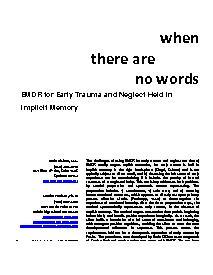When there are no words : EMDR for Early Trauma and Neglect Held in Implicit Memory
The challenges of using EMDR for early trauma and neglect are that a) EMDR readily targets explicit memories, but early trauma is held in implicit memory in the right hemisphere (Siegel, Schore) and is not typically subject to direct recall, and b) Accessing the felt sense of early experience can be overwhelming if it includes the paucity of internal resources of a neglected baby. This workshop addresses both problems by careful preparation and systematic trauma reprocessing. The preparation includes 1) containment, 2) safe state, and 3) resetting innate emotional resources, which appears to directly act upon primary process affective circuits (Panksepp, 2009) to down-regulate the experience of emotional intensity. After the three preparation steps, the method systematically reprocesses early trauma, in the absence of explicit memory. The method targets consecutive time periods beginning before birth, and installs positive experience imaginally. As a result, the client builds a foundation of a felt sense of attachment and belonging, with emergent positive cognitions, enabling the client to meet the next developmental milestone in sequence. This process meets the requirements laid out for a therapeutic reparation of early trauma by Fosha.
Geachte bezoeker,
De informatie die u nu opvraagt, kan door psychotraumanet niet aan u worden getoond. Dit kan verschillende redenen hebben,
waarvan (bescherming van het) auteursrecht de meeste voorkomende is. Wanneer het mogelijk is om u door te verwijzen naar de bron
van deze informatie, dan ziet u hier onder een link naar die plek.
Als er geen link staat, kunt u contact opnemen met de bibliotheek,
die u verder op weg kan helpen.
Met vriendelijke groet,
Het psychotraumanet-team.
33
https://emdr-belgium.be/wp-content/uploads/2017/12/When-There-Are-No-Words.-EMDR-for-Early-Trauma-and-Neglect-Held-in-Implicit-Memory.-Katie-OShea-M.S.-2009.pdf


